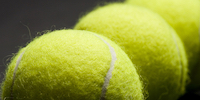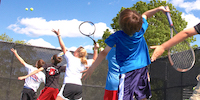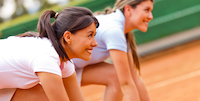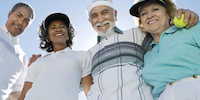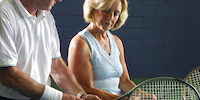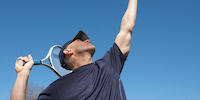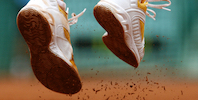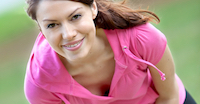Q. While I have no doubt that muscular players like Serena or Nadal don’t muscle their shots, I’m confused about why they build so much muscle weight on their arms. They must do it for some advantages, right? Do you have any ideas?
A. Frankly, I am surprised that there are not more players who are as muscular as Rafael Nadal or Serena Williams. I predict that in ten years, more top-ranking players will be built like Rafa and Serena. The game continues to get increasingly physical. Added strength, indeed muscle, will help players.
By the way, in comparison to bodybuilders, Rafael Nadal would be considered incredibly skinny. So realize that ‘muscular arms’ is a relative term. His bulk has certainly not had an adverse affect on his agility or racquet head speed.
Q. Recently I have been lifting weights while also taking tennis lessons. Although I am getting stronger, I have found that my arm is sore while playing tennis and I am not able to hit as accurately or with as much pace. Should I stop lifting weights all together and just focus on tennis?
A. You might want to lift weights more prudently. If you are trying to “max out” on lifts before taking the court, then your arm will be at greater risk. Also, be sure to concentrate on the muscles that are most crucial for “tennis strength” (and these include the legs, your core muscles, the shoulder region and upper back muscles).
After you have completed a weight training session, grab a racquet and take some practice swings for each of your primary strokes. This will assure that those muscles that were recruited for the training session are kept loose. When you have completed a weightlifting session, be sure to spend some time “cooling down” and then stretching. This final part is often neglected and it may be a factor in your soreness.
Q. How do you build upper body strength without losing touch and racquet head speed? Whenever I lift weights (low weight and high reps), I feel like I am hitting the ball late. It takes 2 sessions of tennis to get back the feel. Do you have any comments on Agassi’s training routine? I am thinking of going to a 3-day tennis camp. What cardio and strength exercises do you recommend to prepare in 3 weeks? I am in good (not great) condition now.
A. It might be a good idea for you to swing the racquet a little- or even play some tennis- after you have trained in the gym. If you hit immediately after a hard workout, then your touch might feel a little compromised initially, but that will return quickly enough. I have read that Andre Agassi spends about 80% of his training time on his legs and core muscles.
If you are not in superior condition and wish to enroll in an intense adult camp, then be judicious. Avoid trying to do too much too quickly. Wear two pairs of socks on your feet and use an overwrap on your racquet to avoid painful blisters. Carry extra dry shirts (and shorts) and be sure to eat healthily and drink plenty of water in the days leading up to the camp. And… have fun!
Q. How can I train my left chest and shoulder? I am asking this because I am a right-handed tennis player who plays with a one-handed backhand. The right side of the body is developing while the other is not. I need your help! Thanks!
A. You might want to engage in some resistance training. By lifting some weights (or, depending on your age, using your body weight- pull-ups, push-ups, bar dips, etc.), you will “even out” your body.
Your premise is accurate though. Tennis players typically become over-developed on their dominant side. You are prudent to correct this, so that you can avoid injuries.
Q. I have recently started playing tennis on a regular basis, and am already noticing that my right arm is steadily getting stronger and bigger than my left. Are there any exercises you suggest to equalize my left arm so I don’t end up looking funny?
A. Consider a bigger, stronger tennis arm to be your personal badge of honor. I doubt that you will ever develop the left forearm/wrist of the great Rod Laver though. During “Rocket” Rod’s prime, he was about 5’ 9” tall and weighed, maybe, 150 pounds. Despite this, relatively, diminutive size, his left forearm was thicker in diameter than the reigning heavyweight champion’s. It was almost like his arm belonged to someone else and was just attached to his shoulder.
In terms of “evening” your body out, I would urge you to supplement your tennis with regular trips to the fitness center for weight training. Lifting weights will help strengthen your deficient areas and keep your body in better balance.
Q. As I’m nearing 40, I’m finding my muscles are aching more and more. I play about twice a week and can’t decide if breaks are good or bad for recovery. Can you recommend an excellent book for stretch exercises for tennis players? Thanks, I really enjoy reading your tips they are very applicable.
A. Make sure that you warm up properly before you begin. Arrive early, then use this extra time before starting play to get loose by doing some dynamic stretches (slow jogging, jumping jacks, swinging your arms in large circles, skipping rope). Ideally, you should be perspiring before you walk on the court to play.
After you finish playing, take a few minutes to go through a range of static stretches (such as touching your toes- and hold each stretch for at least twenty seconds). Also, force yourself to drink more water and a sports drink with electrolytes after you are done. Within one hour of finishing, also have a snack with carbohydrates.
You are correct in realizing that you need to prepare differently as you get older. Try to be more diligent with your preparation and your post-match recovery and you should feel better.
from the USTA
